Updated: August 5, 2024- 13 min read
As a Product Manager, I can’t emphasize enough the importance of a good product backlog. It plays a key role in a Product Manager’s life, given that it’s the first deliverable owned by the Product Manager. Getting it right will lay a strong foundation for your product.
— Rashi Kaushik, Senior Product Manager at Expedia in Product Backlog: Create, Prioritize & Organize
What keeps a project alive and firing on all cylinders? Your team, of course — their ability to work purposefully towards the goals and move inch by inch in an organized manner.
Now, what helps the team play in tune? It's the Product Backlog — the heartbeat of Agile and Scrum methodologies.
This list of Product Backlog examples not only captures every desired feature and enhancement but also shares the priorities and breaks down detailed activities of the project. It puts order in what would otherwise be chaos.
Dive into this article to learn how to create and manage a product backlog effectively, learn from common mistakes, and draw inspiration from some of the best examples out there. Whether you're a seasoned Scrum Master or new to Agile, understanding the Product Backlog is crucial to delivering successful projects.
Feature Prioritization Template
Use this feature prioritization template to get clear direction on which features to include and which to leave out.
Download Free
What is a Product Backlog?
A Product Backlog is a dynamic, prioritized list of backlog items — features, enhancements, and bug fixes that guide the development’s work on a product.
Rooted in Agile and Scrum methodologies, the backlog serves as the single source of truth for what needs to be done. It ensures that the team focuses on the most valuable tasks first, aligning product development with business priorities.
Its importance today is obvious — nearly every project management software includes a backlog view. Nothing comes even close to helping teams organize and track their work.
A well-maintained backlog evolves with the project. Teams are able to incorporate feedback and change requirements to keep everyone on track so they can deliver value continuously.
Who Prioritizes the Product Backlog?
Product Managers are responsible for the strategic direction of the backlog. They determine the order of items based on factors such as business value, customer needs, market conditions, and feedback from stakeholders. In Agile organizations, the Product Owner is responsible for the day-to-day tasks related to the backlog such as refinement and bug fixes. The difference between Product Manager and Product Owner varies from company to company, but for the most part the role of PM with regards to the backlog is more strategic, while the PO is more focused on the details.
What is a Backlog in Agile and Scrum?
According to the Scrum Guide, the Product Backlog is a constantly updated and prioritized list of bits and pieces needed to enhance the product.
The Scrum guide advises teams to update and refine items regularly as these items gain clarity through this process. Refining the Scrum Product Backlog means breaking down items into smaller, more specific tasks. This ongoing process involves adding details like descriptions, priorities, and sizes, which can vary depending on the type of work.
The team members responsible for the work estimate its size. The Product Owner can guide the team by helping them understand priorities and make decisions. When multiple Scrum teams work on the same product, they share a single Product Backlog to outline the future work.

How to Manage a Product Backlog
Product backlog management is a crucial task for product owners and project managers alike. Here are detailed, practical tips to help teams keep their backlog organized and productive:
Clearly Define Each Task: Ensure every task has a clear description, acceptance criteria, and relevant details. This helps the development team understand the requirements and reduces the need for constant clarification.
Prioritize Ruthlessly: Focus on the most valuable tasks first. Regularly review and reorder items based on their importance and impact on the product.
Create a Product Roadmap: Develop a high-level product roadmap that aligns with your strategic goals. This helps guide the prioritization of Product Backlog items and provides a clear vision for the team.
Refine Regularly: Continuously break down large tasks into smaller, more manageable items. This ensures clarity and makes it easier for the development team to estimate and complete tasks within a sprint.
Keep it Detailed: Add clear descriptions, acceptance criteria, and relevant details to each backlog item. This helps the development team understand the requirements and reduces the need for constant clarification.
Engage Stakeholders: Regularly communicate with stakeholders to gather feedback and adjust priorities. This ensures that the backlog reflects the latest business needs and customer feedback.
Estimate Effort: Work with your development team to estimate the effort required for each backlog item. Use techniques like story points or t-shirt sizing to gauge the complexity and time needed.
Limit the Size: Avoid letting your backlog become an overwhelming list of tasks. Keep it concise by archiving outdated or low-priority items. This helps maintain focus on what’s most important.
Use Visual Tools: Utilize product management tools with backlog views to visualize tasks and their priorities. These tools can help you track progress and ensure everyone is on the same page.
Review and Adapt: Regularly review the backlog and adapt it based on new information, market changes, or team feedback. This keeps the backlog relevant and aligned with the project’s goals.
Schedule Regular Backlog Grooming Meetings: Hold consistent backlog refinement meetings to review, refine, and prioritize tasks. This keeps the backlog up-to-date and ensures the team is prepared for upcoming sprints.
Avoid Overloading the Backlog: Keep your backlog manageable by avoiding the addition of too many tasks at once. Focus on high-priority items and archive or remove less critical tasks.
Involve Your Team: Engage your development team in the backlog management process. Their input on task complexity, dependencies, and priorities is invaluable for maintaining a realistic and achievable backlog.

5 Product Backlog Examples You Should Consider
A well-constructed product backlog is key to guiding your team and ensuring project success in Agile and Scrum. Here, we’ll provide product backlog samples for inspiration and guidance. Whether you're experienced or new to Agile, these examples will help you create an effective product backlog.
Sprint Backlog Example 1: Scrum Product Backlog in Jira
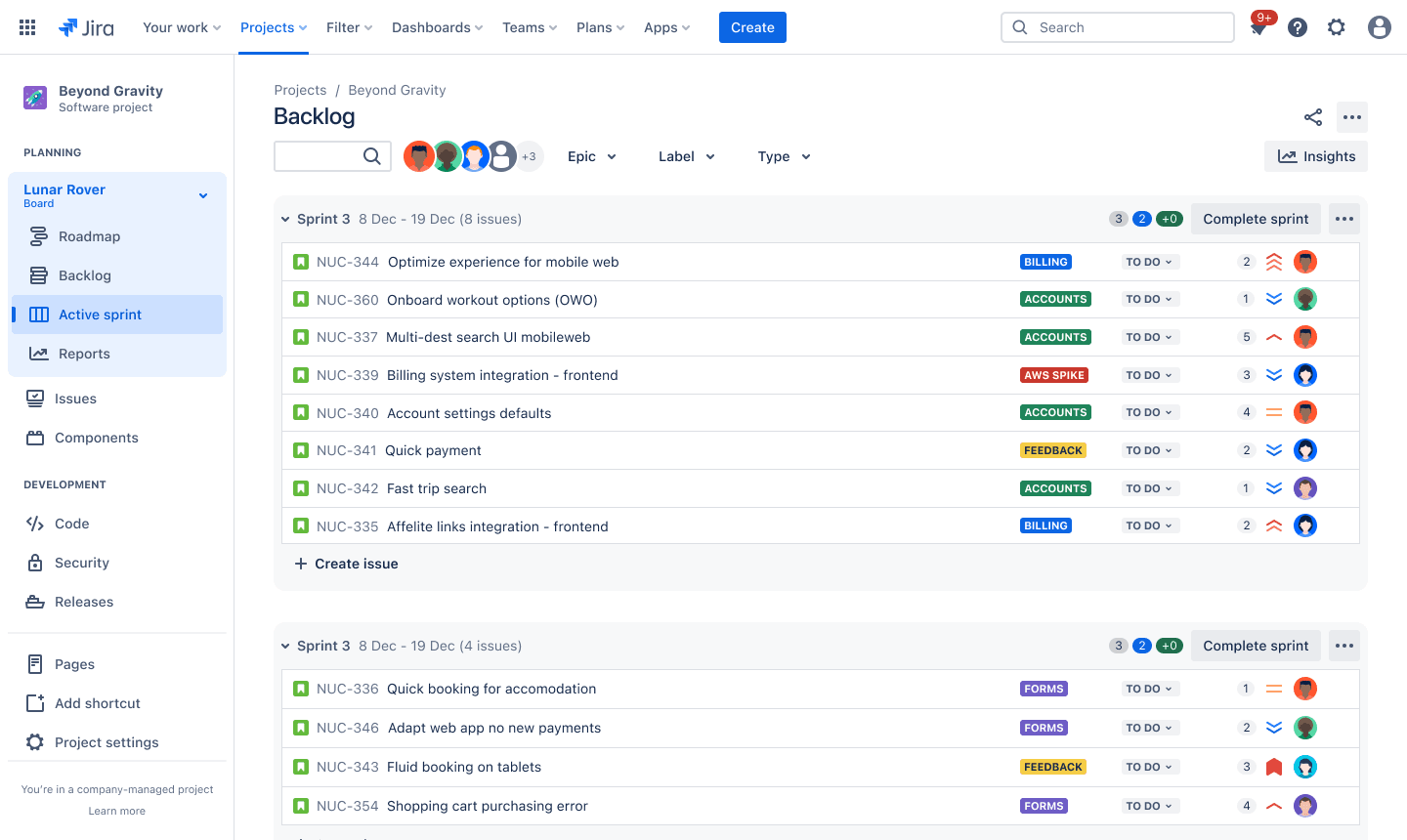
Source: Atlassian.com
A backlog view structured by sprints allows teams to organize their tasks and user stories based on the iterations they plan to complete. The visual representation helps teams stay focused and track progress in real time.
Benefits of Structuring by Sprints
Clear Focus: Each sprint has a defined set of tasks, which helps the team focus on completing specific goals within a given timeframe. This leads to better productivity and clearer milestones.
Efficient Planning: Breaking down the product backlog into sprints makes planning more manageable. It allows the team to estimate effort and allocate resources effectively for each sprint.
Progress Tracking: The sprint-based structure provides a clear view of progress. Teams can easily see what has been completed, what is in progress, and what is planned for future sprints.
Flexibility: This approach allows teams to adapt to changes quickly. At the end of each sprint, the backlog can be reassessed and reprioritized based on new information or shifting priorities.
Challenges and Considerations
Dependency Management: While focusing on individual sprints, it’s crucial to manage dependencies between tasks effectively. Overlooking dependencies can lead to bottlenecks and delays.
Continuous Refinement: The product backlog needs constant attention. Regular refinement sessions ensure that tasks are well-defined, prioritized correctly, and ready for upcoming sprints.
Alignment with Goals: Ensuring that each sprint contributes towards the overall product goals is essential. It’s easy to get lost in completing tasks without keeping the bigger picture in mind.
By structuring the product backlog around sprints, teams can maintain a clear and organized workflow, improving their ability to deliver valuable features incrementally and efficiently.
Scrum Backlog Example 2: Product Backlog in Kanban View
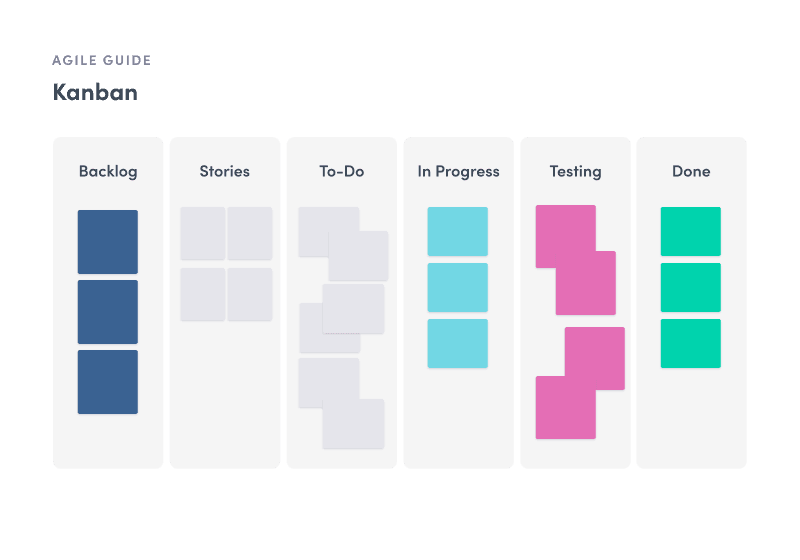
A Scrum Product Backlog in Kanban View is organized by columns representing different stages of the workflow, such as design, development, testing, and done. This visual method helps teams manage tasks through each phase of the process.
Benefits of Structuring by Kanban Columns
Visual Progress Tracking: The Kanban view provides a clear visual representation of the task flow, allowing the team to see the status of each item at a glance.
Work-in-Progress Limits: This method helps in setting limits on the number of tasks in each column, preventing the team from being overloaded and ensuring a smooth workflow.
Continuous Improvement: By regularly reviewing the board, teams can identify bottlenecks and areas for improvement, leading to more efficient processes.
Flexibility: The Kanban board is adaptable to changes. Teams can easily move tasks between columns as priorities shift or new information becomes available.
Challenges and Considerations
Maintaining Flow: It's crucial to ensure that tasks move steadily through the workflow stages. Stagnant tasks can indicate issues that need addressing.
Regular Updates: The board requires constant updates to reflect the current status of tasks accurately. This keeps everyone on the same page and maintains transparency during the sprint.
Detailed Task Breakdown: Each task needs to be clearly defined and broken down into manageable pieces.
By structuring the product backlog in a Kanban view, teams can manage their workflow more effectively. It ensures that tasks are completed efficiently and that progress is continuously monitored and improved.
Agile Product Backlog Example 3: Jira Epic Panel View
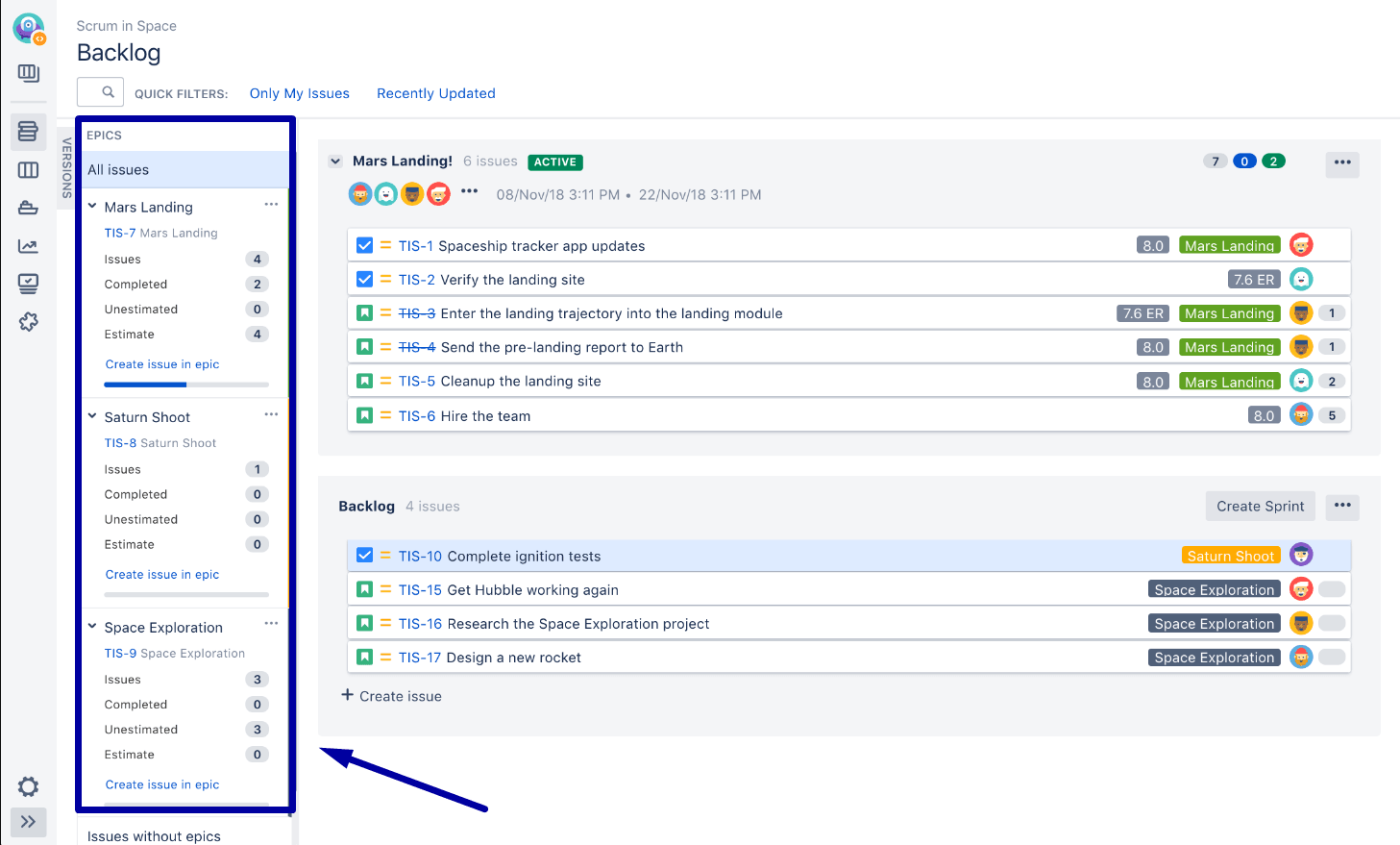
Source: Atlassian.com
An Agile Product Backlog in Jira’s Epic Panel View is structured by epics, with tasks organized under each epic. This method helps teams manage larger features and track progress on major initiatives.
Benefits of Structuring by Epics
Big Picture Visibility: Organizing tasks by epics allows teams to see the bigger picture and understand how individual tasks contribute to larger goals.
Improved Planning: Epics help in breaking down large features into smaller, manageable tasks, making it easier to plan and estimate effort.
Enhanced Focus: Teams can focus on completing one epic at a time, which helps in delivering incremental value and maintaining a clear direction.
Better Alignment: This structure ensures that all tasks within an epic are aligned with the overarching project goals, improving coherence and coordination.
Challenges and Considerations
Complexity Management: Managing multiple epics can become complex. It's important to keep epics and their associated tasks well-organized to avoid confusion.
Dependency Tracking: Tasks within different epics may have dependencies. Proper tracking and communication are essential to ensure smooth progress.
Regular Updates: The epic panel view requires regular updates to reflect the current status of each task and epic accurately. This maintains transparency and keeps everyone informed.
By structuring the product backlog through epics, teams can effectively manage larger features and ensure that all tasks contribute to significant project milestones, improving overall project management and delivery.
Example 4: Product Backlog Example With User Stories
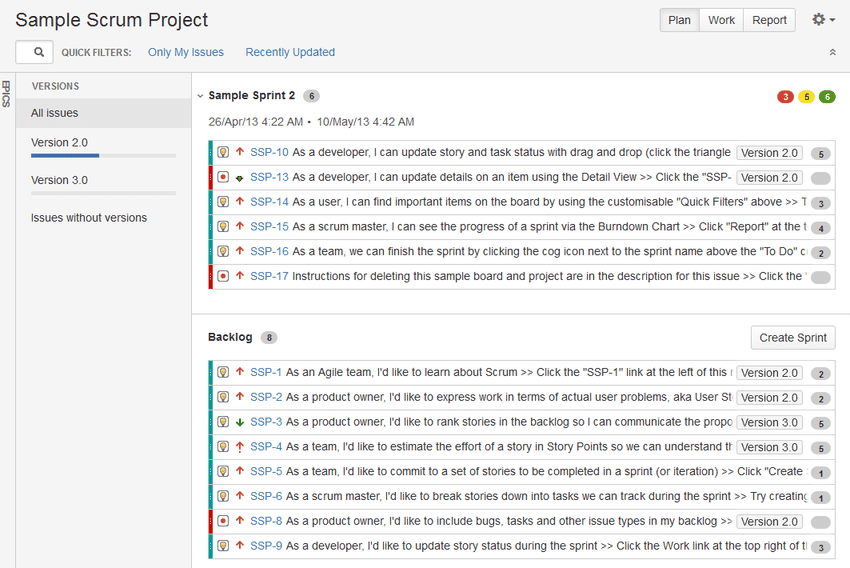
Source: Atlassian.com
A User Story-Based Backlog organizes tasks into user stories, each detailing a specific user need or requirement. This method ensures the development process is user-centric and focused on delivering value to stakeholders.
Benefits of Structuring by User Stories
User-Centric Focus: Each task is framed from the perspective of the user, ensuring that the development is driven by user needs and priorities.
Clear Requirements: The user story format clearly outlines what needs to be achieved, providing a straightforward understanding of each task.
Version Tracking: Associating tasks with specific versions helps in planning and tracking progress across different stages of the project.
Challenges and Considerations
Complexity Management: As the backlog grows, it can become challenging to manage and prioritize a large number of user stories effectively.
Dependency Tracking: Dependencies between user stories need to be carefully managed to avoid bottlenecks and ensure smooth progress.
Continuous Refinement: Regular updates and refinement of the backlog are necessary to keep user stories relevant and accurately described.
By organizing the product backlog through user stories, teams can focus on delivering features that directly benefit users, ensuring that development efforts are aligned with user needs and business goals.
Product Backlog Example 5: Issue Type-Based Backlog
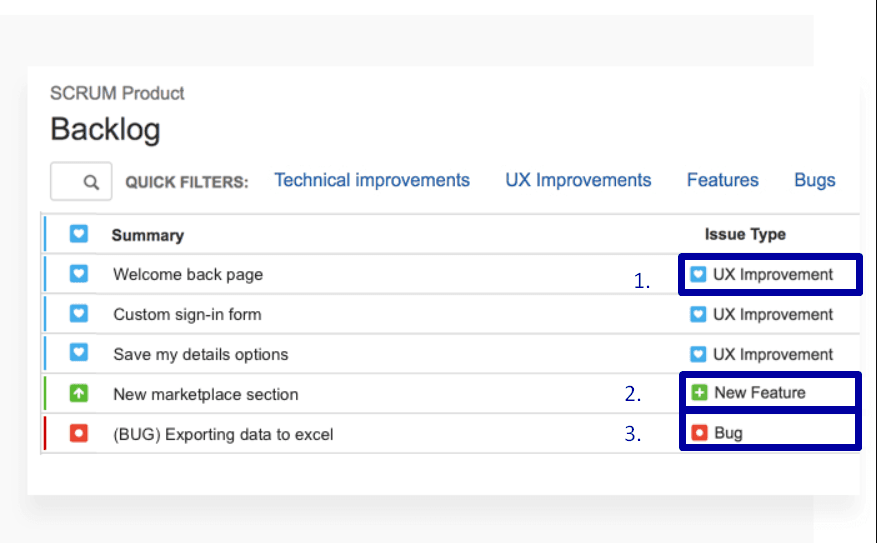
Source: Atlassian.com
An Issue Type-Based Backlog organizes tasks by their nature, such as UX improvements, new features, and bugs. This method helps teams prioritize and address different types of work systematically.
Benefits of Structuring by Issue Type
Focused Resolution: Categorizing tasks by issue type allows teams to focus on specific kinds of work, such as resolving bugs or implementing new features.
Improved Prioritization: This structure helps in prioritizing tasks based on their impact. For example, critical bugs can be addressed immediately, while new features can be planned for future sprints.
Clear Organization: Different types of tasks are clearly distinguished, making it easier to manage and track progress within each category.
Additional Issue Types for Organization
Technical Debt: Tasks aimed at refactoring code or addressing technical debt to improve long-term maintainability.
Performance Improvements: Items focused on enhancing the performance and speed of the application.
Security Enhancements: Tasks related to improving the security of the product, such as implementing new security measures or fixing vulnerabilities.
Documentation: Tasks for creating or updating documentation, which is crucial for both internal and external users.
Research and Spikes: Activities related to investigating new technologies or solutions, often used to gather information before implementing a feature.
Customer Feedback: Issues raised based on direct customer feedback, aimed at improving user satisfaction.
Compliance and Regulatory: Tasks ensuring the product meets industry standards and regulatory requirements.
Challenges and Considerations
Balancing Priorities: It’s essential to balance different types of work to avoid focusing too much on one category while neglecting others.
Dependency Management: Tasks across different issue types may have dependencies, which need to be tracked and managed to ensure smooth progress.
Regular Review: Consistent review and updating of the backlog are necessary to ensure that priorities remain aligned with business goals and user needs.
By structuring the product backlog through issue types, teams can systematically address various aspects of the product, ensuring a well-rounded and thorough development process.
Continually Optimize Your Product Backlog
Effectively managing a product backlog is crucial for successful product delivery.
By exploring different ways to structure your backlog, such as by sprints, Kanban columns, epics, user stories, or issue types, you can find the method that best suits your team's workflow. Each approach has its own benefits and challenges. Therefore, try to pay close attention to your team as it can help you optimize your process.
Remember, consistent refinement and experimentation keep your backlog in top shape. We invite you to do your due — your team will prosper because of it!
Product Roadmapping Micro-Certification (PRC)™️
Product School has partnered with Productboard to create a micro-certification on how to build and maintain effective Roadmaps. Enroll for free to learn how to communicate the product vision and strategy to your stakeholders and customers.
Enroll for Free
Updated: August 5, 2024




